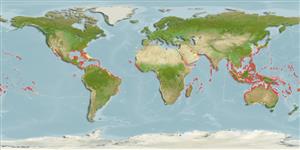Common names from other countries
>
Beloniformes (Needle fishes) >
Exocoetidae (Flyingfishes)
Etymology: Parexocoetus: Greek, para in the side of + Greek, exos = outside + Greek, koite = hole (Ref. 45335).
More on author: Richardson.
Environment: milieu / climate zone / depth range / distribution range
Sinh thái học
Biển; Ở đại duơng, biển (Ref. 51243); Mức độ sâu 0 - 20 m. Subtropical; 37°N - 35°S, 34°E -
Indo-Pacific: widespread from East Africa, including the Red Sea (Ref. 26165) to southern Japan, Hawaii, the Marquesas, and Queensland (Australia); separate population in the eastern tropical Pacific (Bay of Panama). Western Atlantic: northeastern Florida, USA and the Bahamas to Brazil (Ref. 7251); common in Caribbean Sea and Lesser Antilles area; less common in the Gulf of Mexico, the Gulf Stream and the western Sargasso Sea (Ref. 3720). Eastern Atlantic: Guinea to Angola (Ref. 4498).
Length at first maturity / Bộ gần gũi / Khối lượng (Trọng lượng) / Age
Maturity: Lm 12.0, range 11 - 13 cm
Max length : 20.0 cm TL con đực/không giới tính; (Ref. 5217); common length : 16.0 cm TL con đực/không giới tính; (Ref. 5217)
Các tia vây lưng cứng (tổng cộng) : 0; Các vây lưng mềm (tổng cộng) : 12 - 14; Tia cứng vây hậu môn: 0; Tia mềm vây hậu môn: 12 - 14. Body iridescent greenish blue dorsally, silvery white ventrally; dorsal black except for base and posterior rays which are pale; pelvic fins greyish, other fins transparent (Ref. 2797).
Occurs in coastal waters (Ref. 9300), rare in the open ocean (Ref. 9839). Capable of leaping out of the water and gliding for considerable distances above the surface. 3-4 individuals aggregate during breeding (Ref. 47825). Carnivorous (Ref. 9137). Not important as food fish, but occasionally taken by fisheries.
During breeding, a spawning aggregation composed at least of 3-4 individuals, probably 2-3 males to 1 female, were observed jumping and flying over the water surface, exuding ripe eggs and sperm in the process.
Spawning on surface substrate (e.g. flotsam) when present is the usual reproductive mode but other modes may be employed if this substrate is not available. The fertilised eggs may remain suspended in the water surface during its development with the help of the small filaments on the egg surface and the adhesive filaments holding the egg mass together, by increasing the surface to volume ratio of the eggs, which aids in propping the eggs up in the water column. The eggs may also be suspended upon current or become benthic.
Parin, N.V., 1996. On the species composition of flying fishes (Exocoetidae) in the West-Central part of tropical Pacific. J. Ichthyol. 36(5):357-364. (Ref. 27313)
IUCN Red List Status (Ref. 130435)
CITES (Ref. 128078)
Not Evaluated
Threat to humans
Harmless
Human uses
Các nghề cá: buôn bán nhỏ
Các công cụ
Special reports
Download XML
Các nguồn internet
Estimates based on models
Preferred temperature (Ref.
115969): 23.3 - 29.2, mean 27.8 (based on 4764 cells).
Phylogenetic diversity index (Ref.
82804): PD
50 = 0.6250 [Uniqueness, from 0.5 = low to 2.0 = high].
Bayesian length-weight: a=0.00646 (0.00292 - 0.01429), b=3.04 (2.84 - 3.24), in cm Total Length, based on LWR estimates for this (Sub)family-body shape (Ref.
93245).
Mức dinh dưỡng (Ref.
69278): 3.4 ±0.45 se; based on food items.
Thích nghi nhanh (Ref.
120179): Chiêù cao, thời gian nhân đôi của chủng quần tối thiểu là dưới 15 tháng (Preliminary K or Fecundity.).
Fishing Vulnerability (Ref.
59153): Low vulnerability (10 of 100).
